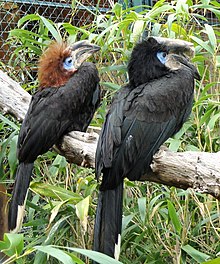Black-casqued hornbill
| Black-casqued hornbill | |
|---|---|

| |
| A pair at the Jardin d'Oiseaux Tropicaux, France (female on left and male on right) | |
| Scientific classification | |
| Domain: | Eukaryota |
| Kingdom: | Animalia |
| Phylum: | Chordata |
| Class: | Aves |
| Order: | Bucerotiformes |
| Family: | Bucerotidae |
| Genus: | Ceratogymna |
| Species: | C. atrata
|
| Binomial name | |
| Ceratogymna atrata (Temminck, 1835)
| |

The black-casqued hornbill (Ceratogymna atrata), or black-casqued wattled hornbill, is a species of hornbill in the family Bucerotidae. It is found fairly commonly across sub-Saharan Africa, being known from Sierra Leone and Liberia in Western Africa (as well as most of the West African nations along the Gulf of Guinea), south to Angola and east to the Democratic Republic of the Congo and western Uganda.[2] The population is decreasing.[3]
Male and female black-casqued hornbill differ in physical appearance and are therefore an example of sexual dimorphism. The males are larger, have black feathers on their head, and have a larger casque. The females have brown hood of feathers.[4]
The black-casqued hornbill is known for its intelligence.[3] They are most commonly found in pairs, but small groups of up to 5 are also somewhat frequent.[3] They feed on insects and at least 19 species of fruit.[3]
References
[edit]- ^ BirdLife International (2016). "Ceratogymna atrata". IUCN Red List of Threatened Species. 2016: e.T22682621A92954110. doi:10.2305/IUCN.UK.2016-3.RLTS.T22682621A92954110.en. Retrieved 11 November 2021.
- ^ "African Bird Club".
- ^ a b c d Rose, Paul E.; Scales, Jake S.; Brereton, James E. (28 April 2020). "Why the "Visitor Effect" Is Complicated. Unraveling Individual Animal, Visitor Number, and Climatic Influences on Behavior, Space Use and Interactions With Keepers—A Case Study on Captive Hornbills". Frontiers in Veterinary Science. 7. doi:10.3389/fvets.2020.00236. ISSN 2297-1769. PMC 7199352.
- ^ "Black-casqued Hornbill – eBird". ebird.org. Retrieved 6 February 2023.
External links
[edit]
Text is available under the CC BY-SA 4.0 license; additional terms may apply.
Images, videos and audio are available under their respective licenses.

